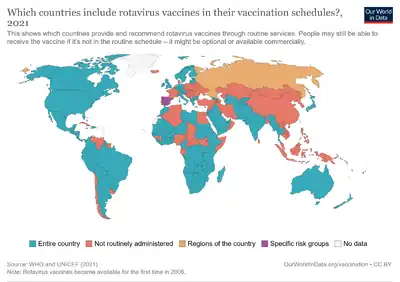National Immunization Technical Advisory Group

National Immunization Technical Advisory Group (NITAG) is an advisory committee consisting of multidisciplinary groups of experts responsible for providing information to national governments that is used to make evidence-based decisions regarding vaccine and immunization policy.[1][2] The majority of industrialized and some developing countries have formally established advisory committees to guide immunization policies; other countries are working towards establishment of such committees.[3]
Purpose
The primary purpose of NITAG is to provide technical resources, supplying guidance and recommendations to national policy makers and programme managers to enable them to make evidence-based immunization related policy and program decisions. This may also include vaccination schedules regarding appropriate timing, dosage, and contraindications of vaccines.[3] To ensure that the government gives proper attention to NITAG recommendations, NITAG usually report to high level officials of the Ministry of Health.[3]
In immunization related policy, Strategic Advisory Group of Experts on Immunization (SAGE) have established mechanisms to synthesize evidence and make global recommendations. Such recommendations will be further interpreted at the country level by NITAGs. As they need to take account of factors such as local disease epidemiology, acceptability of vaccination strategies to local populations, equity in local populations, and programmatic and financial constraints.[4]
In 2011, the World Health Organization (WHO) recommended that NITAG be established in each member country.[5] The Global Vaccine Action Plan (GVAP) requested all 194 members countries to establish, or have access to, a NITAG by 2020.[6]
NITAG are considered to be functional when they meet six defined process indicators agreed upon by the WHO, which are:[7]
- having a legislative or administrative basis,
- having formal terms of reference,
- having at least five areas of expertise represented among its membership,
- having at least one meeting per year,
- distribution of the agenda and background documents at least one week prior to meetings, and
- having mandatory disclosure of conflict of interests.
As of 2021, there are 172 countries reporting existence of NITAG and 121 countries with NITAG with all six WHO functionality criteria.[8] And 85% of the world’s population is served by such NITAGs, 52% increase compared to 2010.[6]
Members
There are no fixed rules about the total number of NITAG members as it depends on local considerations such as the need for geographic representation, the size of the country, and the availability of resources. However, experience has shown that successful NITAG function with about 10–15 members.[3] NITAG members typically consist of multidisciplinary experts and represent a broad range of skills and expertise from the following disciplines/areas: clinical medicine (paediatrics and adolescent medicine, adult medicine, geriatrics), epidemiologists, infectious diseases specialists, microbiologists, public health, immunology, vaccinology, immunization programme, health systems and delivery, clinical research and health economics.[3][9]
List of NITAG
There are no specific guideline on naming of NITAG. Therefore, NITAG in each country may have different names, for example:
- Australia: Australian Technical Advisory Group on Immunisation (ATAGI)
- Canada: National Advisory Committee on Immunization (NACI)
- France: Technical Committee of Vaccination (Comité Technique des Vaccinations / CTV)[10]
- Germany: Standing Committee on Vaccination (Ständige Impfkommission am Robert-Koch-Institut / STIKO)
- India: National Technical Advisory Group on Immunisation (NTAGI)[11]
- Ireland: National Immunisation Advisory Committee (NIAC)
- United Kingdom: Joint Committee on Vaccination and Immunisation (JCVI)
- United States: Advisory Committee on Immunization Practices (ACIP)
References
- ↑ Gessner, Bradford D.; Duclos, Philippe; DeRoeck, Denise; et al. (19 April 2010). "Informing decision makers: Experience and process of 15 National Immunization Technical Advisory Groups". Vaccine. Elsevier. 28 (1): A6-12. doi:10.1016/j.vaccine.2010.02.025. PMID 20412988.
- ↑ "National advisory committees on immunization". who.int. WHO. June 2019. Archived from the original on 1 February 2020. Retrieved 22 January 2020.
- 1 2 3 4 5 Duclos, Philippe (19 April 2010). "National Immunization Technical Advisory Groups (NITAGs): Guidance for their establishment and strengthening" (PDF). Vaccine. Elsevier. 28 (1): A18-25. doi:10.1016/j.vaccine.2010.02.027. PMID 20412991. Archived (PDF) from the original on 19 January 2022. Retrieved 28 January 2023.
- ↑ Steffen, Christoph A.; Henaff, Louise; Durupt, Antoine; et al. (8 April 2021). "Evidence-informed vaccination decision-making in countries: Progress, challenges and opportunities". Vaccine. Elsevier. 39 (15): 2146–2152. doi:10.1016/j.vaccine.2021.02.055. PMID 33712350.
- ↑ Duclos, Philippe; Dumolarda, Laure; Abeysingheb, Nihal; et al. (2013). "Progress in the establishment and strengthening of national immunization technical advisory groups: Analysis from the 2013 WHO/UNICEF joint reporting form, data for 2012". Vaccine. Elsevier (published 4 November 2013). 31 (46): 5314–5320. doi:10.1016/j.vaccine.2013.08.084. PMID 24055304.
- 1 2 WHO (2019). The Global Vaccine Action Plan 2011-2020 • Review And Lessons Learned. Geneva: WHO. Archived from the original on 19 December 2017. Retrieved 28 January 2023.
- ↑ "SAGE April 2017 - NITAGs - Background Paper" (PDF). World Health Organization. April 2017. Archived (PDF) from the original on 19 January 2022. Retrieved 28 January 2023.
- ↑ "National Immunization Advisory Mechanism". World Health Organization. Archived from the original on 28 November 2022. Retrieved 28 November 2022.
- ↑ "ACIP charter". National Center for Immunization and Respiratory Diseases. 1 April 2014. Archived from the original on 21 November 2015. Retrieved 20 November 2015.
- ↑ "Vaccine Committee". Haute Autorité de Santé. 14 September 2019. Archived from the original on 20 August 2021. Retrieved 29 January 2020.
- ↑ "Press Note". Government of India Press Information Bureau. 8 February 2017. Archived from the original on 22 June 2020. Retrieved 29 January 2020.
External links
- NITAG Resource Center page Archived 2 February 2023 at the Wayback Machine